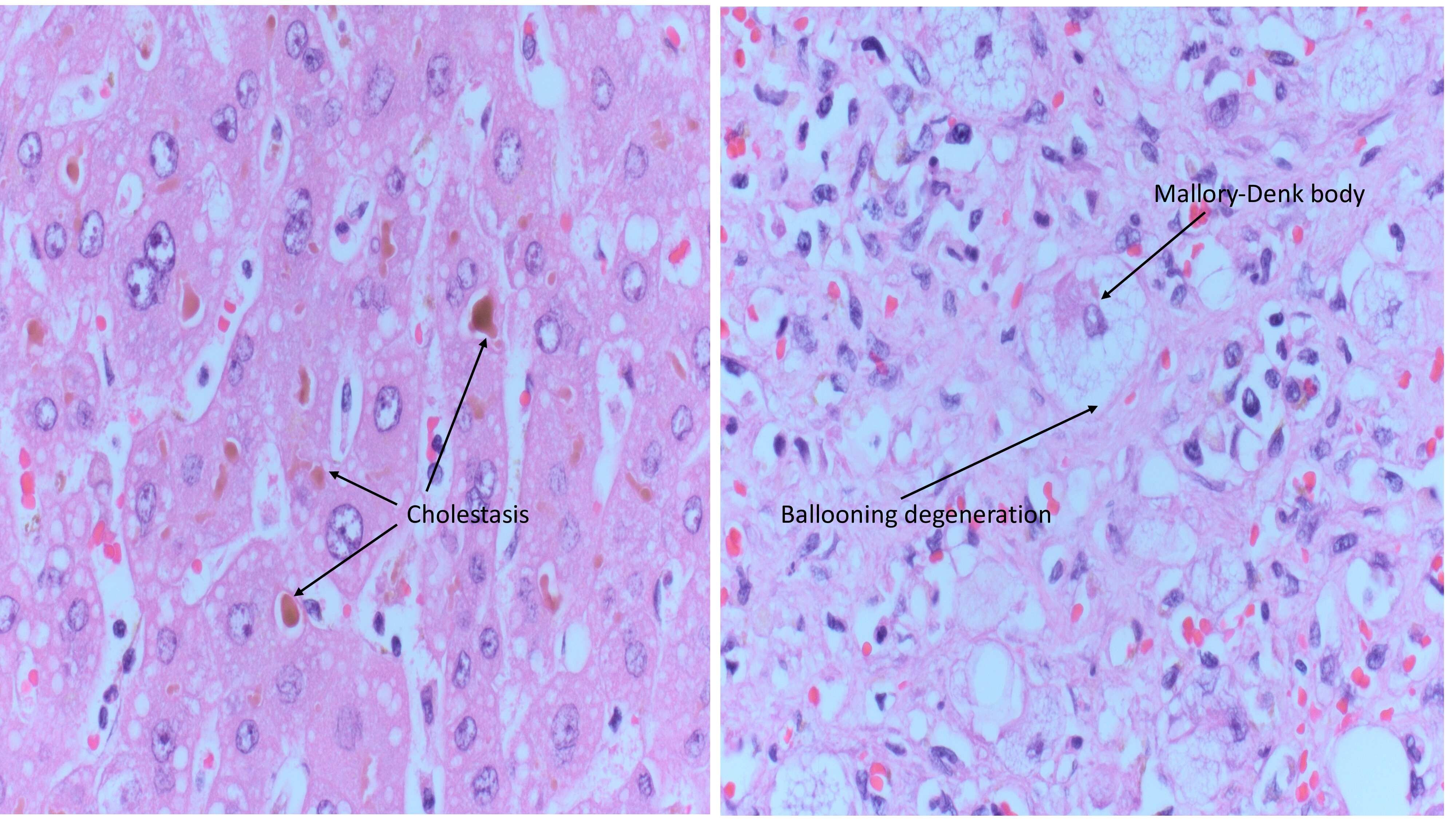Back


Poster Session D - Tuesday Morning
Category: Liver
D0571 - Acute Liver Failure in an Incidentally COVID-19 Positive Patient With No Respiratory Symptoms
Tuesday, October 25, 2022
10:00 AM – 12:00 PM ET
Location: Crown Ballroom

Has Audio

Ritwick Mynam, BS
University of Texas Health Science Center
San Antonio, Texas
Presenting Author(s)
Ritwick Mynam, BS1, Saatchi Kuwelker, MD2, Ariadna Perez Sanchez, MD1, Allison Harrington, MD1, Jacob Ritter, MD1, Ricardo De la Cruz, MD1
1University of Texas Health Science Center, San Antonio, TX; 2UT Health San Antonio, San Antonio, TX
Introduction: Given that COVID-19 uses angiotensin converting enzyme 2 as its primary viral entry receptor, which is present on multiple organs including the liver, it has the capacity to cause severe systemic disease. Several studies have documented elevations in liver associated enzymes (LAE), in patients with COVID-19 ranging from 2 to 50 % above baseline. Currently, it is not entirely clear whether LAE elevations can be used for prognostication purposes. Here, we present a case of COVID-19 induced fulminant liver failure in an otherwise asymptomatic non-hypoxemic patient.
Case Description/Methods: A 50 year-old male with no significant past medical history who had recently recovered from a mild COVID-19 infection ten days prior presents with symptoms of fatigue, abdominal pain, nausea and vomiting for three days. Physical exam revealed diffuse abdominal tenderness and scleral icterus. Patient denied recent travel, alcohol use, contact with animals, multiple sexual partners, or drug/medication use. Lab findings were significant for elevation of aspartate transaminase, alanine transaminase, total bilirubin, and INR of 4985 IU, 9895 IU, 11 mg/dl and >9 respectively. CT abdomen revealed periportal edema with perihepatic free fluid. In conjunction with marked hepatocellular transaminitis, these findings were concerning for acute hepatitis. However, viral panels including Hepatitis A, B, C, D, E, EBV, CMV and HSV were negative. Drug screens, autoimmune panel, ceruloplasmin level and fungal panels were also negative. Over the next 3 days patient developed lactic acidosis, shock, hepatic encephalopathy, and liver and kidney failure that necessitated ICU admission. Deemed to be too unstable for a liver transplant, despite aggressive supportive measures, the patient died on the 5th day of hospital stay. A post-mortem evaluation of hepatic tissue revealed extensive cholestasis, mild mixed steatohepatitis, Mallory bodies, periportal fibrosis, ballooning hepatocytes, and lymphocytic infiltrates throughout the parenchyma.
Discussion: Although COVID-19 infections presenting with hypoxemia have shown to present with elevated LAEs in the past, very few cases of fulminant liver failure in an otherwise non-hypoxemic patient have been documented. In the setting of no other explanation for acute liver failure, it could be hypothesized that COVID-19 induced viral hepatitis or hypercoagulability leading to a Budd Chiari-like syndrome could have potentiated liver failure in this patient.

Disclosures:
Ritwick Mynam, BS1, Saatchi Kuwelker, MD2, Ariadna Perez Sanchez, MD1, Allison Harrington, MD1, Jacob Ritter, MD1, Ricardo De la Cruz, MD1. D0571 - Acute Liver Failure in an Incidentally COVID-19 Positive Patient With No Respiratory Symptoms, ACG 2022 Annual Scientific Meeting Abstracts. Charlotte, NC: American College of Gastroenterology.
1University of Texas Health Science Center, San Antonio, TX; 2UT Health San Antonio, San Antonio, TX
Introduction: Given that COVID-19 uses angiotensin converting enzyme 2 as its primary viral entry receptor, which is present on multiple organs including the liver, it has the capacity to cause severe systemic disease. Several studies have documented elevations in liver associated enzymes (LAE), in patients with COVID-19 ranging from 2 to 50 % above baseline. Currently, it is not entirely clear whether LAE elevations can be used for prognostication purposes. Here, we present a case of COVID-19 induced fulminant liver failure in an otherwise asymptomatic non-hypoxemic patient.
Case Description/Methods: A 50 year-old male with no significant past medical history who had recently recovered from a mild COVID-19 infection ten days prior presents with symptoms of fatigue, abdominal pain, nausea and vomiting for three days. Physical exam revealed diffuse abdominal tenderness and scleral icterus. Patient denied recent travel, alcohol use, contact with animals, multiple sexual partners, or drug/medication use. Lab findings were significant for elevation of aspartate transaminase, alanine transaminase, total bilirubin, and INR of 4985 IU, 9895 IU, 11 mg/dl and >9 respectively. CT abdomen revealed periportal edema with perihepatic free fluid. In conjunction with marked hepatocellular transaminitis, these findings were concerning for acute hepatitis. However, viral panels including Hepatitis A, B, C, D, E, EBV, CMV and HSV were negative. Drug screens, autoimmune panel, ceruloplasmin level and fungal panels were also negative. Over the next 3 days patient developed lactic acidosis, shock, hepatic encephalopathy, and liver and kidney failure that necessitated ICU admission. Deemed to be too unstable for a liver transplant, despite aggressive supportive measures, the patient died on the 5th day of hospital stay. A post-mortem evaluation of hepatic tissue revealed extensive cholestasis, mild mixed steatohepatitis, Mallory bodies, periportal fibrosis, ballooning hepatocytes, and lymphocytic infiltrates throughout the parenchyma.
Discussion: Although COVID-19 infections presenting with hypoxemia have shown to present with elevated LAEs in the past, very few cases of fulminant liver failure in an otherwise non-hypoxemic patient have been documented. In the setting of no other explanation for acute liver failure, it could be hypothesized that COVID-19 induced viral hepatitis or hypercoagulability leading to a Budd Chiari-like syndrome could have potentiated liver failure in this patient.

Figure: Figure1a (left): Liver biopsy at the time of autopsy showing cholestasis and mild mixed steatohepatitis
Figure1b (right): Liver biopsy at the time of autopsy showing ballooning degeneration and Mallory Denck bodies
Figure1b (right): Liver biopsy at the time of autopsy showing ballooning degeneration and Mallory Denck bodies
Disclosures:
Ritwick Mynam indicated no relevant financial relationships.
Saatchi Kuwelker indicated no relevant financial relationships.
Ariadna Perez Sanchez indicated no relevant financial relationships.
Allison Harrington indicated no relevant financial relationships.
Jacob Ritter indicated no relevant financial relationships.
Ricardo De la Cruz indicated no relevant financial relationships.
Ritwick Mynam, BS1, Saatchi Kuwelker, MD2, Ariadna Perez Sanchez, MD1, Allison Harrington, MD1, Jacob Ritter, MD1, Ricardo De la Cruz, MD1. D0571 - Acute Liver Failure in an Incidentally COVID-19 Positive Patient With No Respiratory Symptoms, ACG 2022 Annual Scientific Meeting Abstracts. Charlotte, NC: American College of Gastroenterology.
